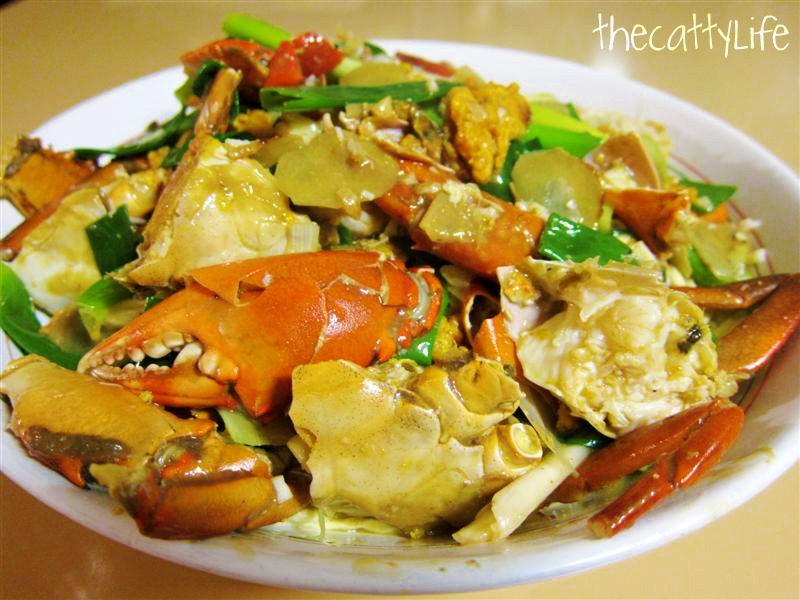
I always say that I love you guys. And I do. Believe me, I do. But with age comes wisdom and through countless disappointments and heartbreaks, I’ve come to learn that actions, they speak a lot louder than words. Am I right or am I right? And because I would never dream to dent, let alone break any of your little hearts, I wanted to show you guys just how much I love y’all, so look what I’ve gone and done! I’ve pried away from my dad one of his prized crab recipes – mud crab noodles with ginger & shallots – and am sharing it here, right here for you.
Ok so actually cooking it for you guys would be the ultimate in love stories but hold yer horses there, I haven’t even cooked this for Panu yet!
Anyway, most people are more familiar with lobster noodles but this is the same thing except here in the catty household, We Is Crab Peoples. But you can totally do the same recipe with lobster if that’s what’s hankering at your taste buds.
So. Without much further ado, let’s get into it. I’ve got some photos here to help us all along, but down the bottom of this post you’ll find the recipe in steps. Happy cooking!

Firstly you need to prepare the mud crabs. Oh wait, if you have a live crab, the most humane way to kill it is to wrap it up in newspaper and freeze the little guy. There are some far more awful ways to de-life a crab, but I won’t go into that. Once frozen, just submerge in a pot of tap water for a couple of hours to defrost.
Now, I have to admit, I had all the intention of actually photographing my dad preparing the crabs but then he went all up and did it while I was napping, didn’t he? Totally not my fault that I was napping. But anyway. Remove the crab’s shell – the easiest way is to start from the belly of the crab. Start from the triangular tip on its belly, lift that towards the back of the crab and literally peel it all the way around until the shell comes off as well.
The shell is full of hepatopancreas (otherwise known as “mayonnaise” or “mustard”). This is good stuff and disturbingly, many people discard this thinking it’s the crab’s poop but please. DON’T. This is what gives any crab dish its flavour so put the hepatopancreas aside in a small bowl.
The only part of the crab that is inedible are its gills. Get rid of them. Wash the crab clean and chop it into manageable bits. My dad usually cuts the body in half down the middle, and each half into half again. He also separates the claw and gives it a little smash so that it’s easier to peel once cooked. You can smash it using a nut cracker, or if you’re my dad, a cleaver. Hellz yeah.
The crab is now ready! Refrigerate!

Then prepare the garlic, ginger and shallots. These are easy. Mix the sauce too. No pics of that, it wasn’t so pretty
You also need to have the right noodles for this dish. I mean, it’s not the end of the world if you use just regular egg noodles, but most restaurants will use this lighter version of egg noodle “yee mien“. This is what we used:

Don’t worry about the noodles for now. They take literally two minutes to prepare so leave them til last. So, let’s start cooking!

Ok, first heat up the oil in a wok or saucepan and brown the garlic. When it’s brown, add the hepatopancreas and stir for about 2-3 minutes. Then add the ginger and stir for another minute or so.

Add the crab and stir until the crab is cooked. You can tell it’s cooked when the shell turns a bright red. If it helps, cover the wok with a lid to quicken the process but it shouldn’t take any longer than five minutes.

Once the crab is cooked, add the sauce. It’s nice to have some gravy with the noodles, so my dad adds about 150mL of water. Check the consistency yourself and if it’s too runny, add corn flour/starch. If you want more sauce, add water.
Not really rocket science, even I can do it.

Once the sauce comes to boil, add the shallots. You don’t have to cook the shallots for long – they should be soft but not overcooked.

Now that the crab is ready, prepare the noodles by placing the dried noodles in a pot and stirring with boiling water for about a minute. Drain and rinse with cold water. Place the noodles in a large serving dish and top with the crab and…. voilà!
Mud crab noodles with ginger and shallots:

This is love on so many different levels… *sigh*
| Mud crab noodles with ginger & shallots |
|---|
| 1 large or 2 small mud crab/s, about 1 kg in total, cleaned 180 grams yee mien or thin egg noodles 2.5 teaspoon corn flour 4 tablespoons ginger wine 2 teaspoon soya sauce 4 tablespoons olive oil Fresh ginger, sliced thinly (my dad used a peeler) 1 whole garlic, diced Shallots, chopped in 6cm portions 150mL water Pinch of salt to taste |
|
| Serves 2-3 as a main course with no other dishes. |